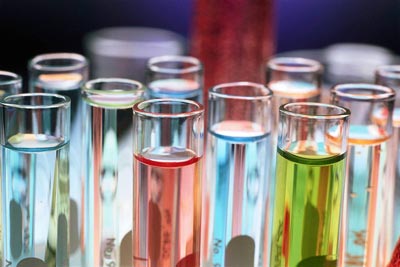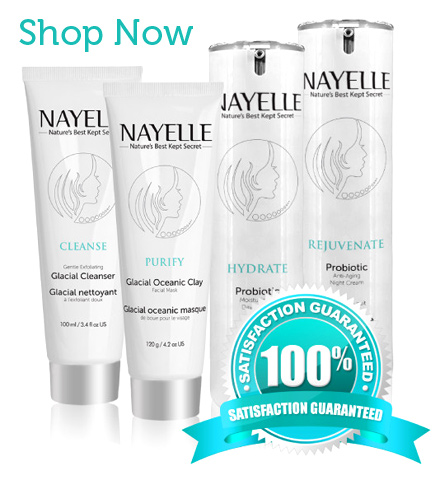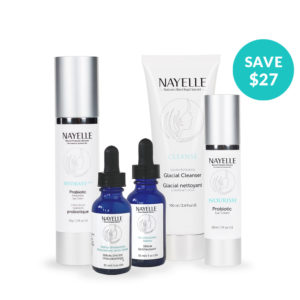Cosmetic Chemicals and Ingredients To Avoid – The Use of Chemicals in Skincare Products
 We come across so many studies and reports regarding the use of chemicals in the cosmetic industry… and it’s not pretty.
We come across so many studies and reports regarding the use of chemicals in the cosmetic industry… and it’s not pretty.
Research shows that one in eight of the approximately 80,000 ingredients used in personal care and cosmetic products are industrial chemicals!
These cosmetic chemicals include a long list of carcinogens, pesticides, reproductive toxins, hormone disruptors, plasticizers (chemicals that keep concrete soft), degreasers (used to get grime off auto parts), and surfactants (they reduce surface tension in water, like in paint and inks).
None of these ingredients should ever come in contact with your skin. These cosmetic chemicals also damage our local environments when they go down our drains. In a much larger scale, they damage the global environment with their production and widespread use.
A recent survey of Canadians (initiated by the David Suzuki Foundation) show that at least one of these “Dirty Dozen” ingredients can be found in 80% of the skincare products entered. It’s time to take a stand and get these products out of our lives. If we continue to buy them, companies will continue to produce them.
The Dirty Dozen – Cosmetic Chemicals Short List
You should avoid these harmful cosmetic chemicals at all costs. Give your skincare, soaps and cosmetics a quick audit and be on the lookout for these chemical names:
- BHA and BHT – Found in many cosmetic products including lipsticks and moisturizers. Classified as possible carcinogens. Long-term exposure to these ingredients has been linked to liver, thyroid, and kidney problems.
- Coal Tar Dyes – On cosmetic labels these will show up as P-phenylenediamine and colours listed as “CI” followed by a number. Found in hair coloring products. Derived from petroleum and composed of many different chemicals, coal tar dyes are recognized as a human carcinogen and have been linked to brain damage.
- DEA-related ingredients – Helps make cosmetic products creamy and can be found in facial cleansers, shampoos, soaps and moisturizers. DEA can cause moderate skin and eye irritation. Sustained exposure has been linked to liver, skin, and thyroid cancers.
- Dibutyl phthalate (DBP) – DBP is a plasticizer used to prevent nail polish from becoming brittle. Consistent use of DBP has been linked to hormonal disruptions and developmental defects in fetuses.
- Formaldehyde-releasing preservatives – On cosmetic labels look for DMDM hydantoin, diazolidinyl urea, imidazolidinyl urea, methenamine, quaternium-15, and sodium hydroxymethylglycinate. These preservatives are used to increase the shelf life of a variety of cosmetics and they work by continuously releasing small amounts of formaldehyde, which is carcinogenic.
- Parabens – Surveys show that up to 90% of cosmetics contain parabens. Parbens are used as preservatives. The ingredient has been linked to hormonal disruptions, breast cancer, increased skin aging, and DNA damage.
- Parfum (a.k.a. fragrance) – The cosmetic industry uses these 2 words “parfum” and “fragrance” to cover over 3,000 different ingredients. They can be found in almost every product. Many unlisted ingredients in fragrances have been linked to health problems like asthma, allergies, and even cancer.
- PEG compounds – Used as thickeners, solvents and moisture-carriers. Depending on the quality and manufacturing process PEG compounds can get contaminated with carcinogenic substances like ethylene oxide and 1,4-dioxane. Even when not contaminated, PEG compounds have been shown to cause skin irritation.
- Petrolatum – Petrolatum is a petroleum jelly used in hair products to add shine and in lip balms, lip sticks, and moisturizers as a moisture barrier. The ingredient is often contaminated with PAHs (polycyclic aromatic hydrocarbons), a known carcinogen and cause skin irritation.
- Siloxanes – Look for ingredients ending in “-siloxane” or “-methicone”. Found in hair products and deodorants they have been found to impair fertility and cause hormonal disruptions.
- Sodium laureth sulfate (SLS) – This foaming agent can be found in cosmetics like cleansers, bubble bath, and shampoo. Many commercial varieties are contaminated with ethylene oxide and 1,4-dioxane. All known carcinogens.
- Triclosan – Found in antibacterial cosmetics like deodorants and hand sanitizers. It can cause skin and eye irritations in the short term, and conditions like antibiotic resistance and hormonal disruptions with sustained use.


